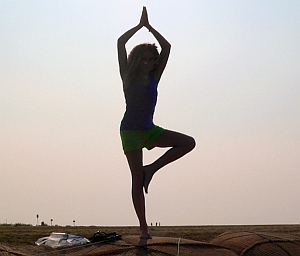Computer scientists at University of Washington in Seattle wrote software for Microsoft Kinect game modules that provides spoken feedback for yoga students with little or no vision. The team led by doctoral student Kyle Rector describes the software known as Eyes-Free Yoga next week at ACM’s SIGACCESS International Conference on Computers and Accessibility in Bellevue, Washington.
Rector, with computer science professor Julie Kientz and research assistant Cynthia Bennett, wrote Eyes-Free Yoga to track the vision-impaired yoga student’s body movements and provide real time auditory feedback for six yoga poses. Kinect is a motion and voice-recognition module for Xbox and Windows platforms that allows users to interact with game-like activities, in this case the practice of yoga.
The software takes advantage of the Kinect’s skeletal tracking capability that monitors the position of 20 body joints. The program measures the difference between key skeletal points and geometrically calculates body angles accordingly. Kinect then gauges the position of the student’s limbs and the software provides spoken instructions to achieve the correct position for the pose being attempted.
Each of the six poses has between seven and 12 rules or indicators of correct positioning, depending on the complexity of the pose. The Kinect first checks the yoga student’s torso and the software suggests alignment changes, followed by the alignment of the head and neck area, and finally position of the arms and legs. The system also gives positive feedback when a person correctly performs a pose.
Rector and colleagues tested the software with 16 vision-impaired yoga students from novices to current practitioners, age 13 to 60, recruited through the Washington State School for the Blind. Each participant completed both structured step-by-step instructions with no feedback and the the same step-by-step instructions, but with spoken feedback. Participants were randomly assigned to start with either the instructions-only or instructions-with-feedback methods, followed by the alternative method.
Participants, as expected needed fewer correcting instructions for the simpler poses with fewer rules, but required more feedback for the more complex and demanding poses. Also as expected, students by and large needed less feedback as they repeated the trials. Nearly all of the participants said they would use the system again, and 13 of the 16 participants said they would recommend the system to others.
Rector tells more about Eyes-Free Yoga in the following video.
- FDA Approves Robotic Device for Stroke Rehabilitation
- Mobility Device with Health Monitor Developed for Disabled
- Augmented Reality Applications Enhanced for Mobile Devices
- Virtual Reality Patients Devised to Train Psychologists
- Device Improves Wheelchair Control for Spinal Cord Injured
* * *


 RSS - Posts
RSS - Posts
You must be logged in to post a comment.